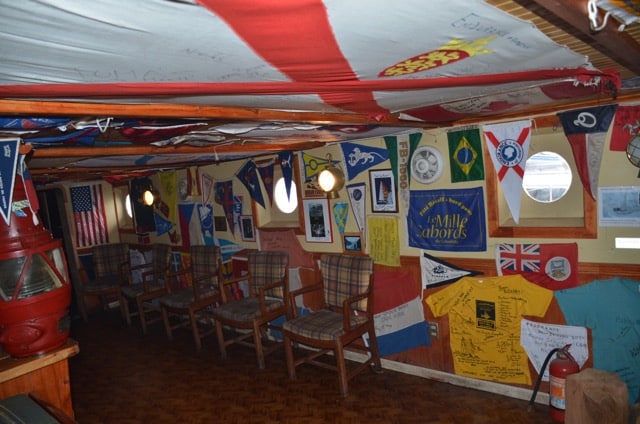
In our last frantic days of getting ready to leave Puerto Williams I thought of how leaving port is just a little like dying.
I’m not talking about a metaphor here, but simply about the practicalities – namely, how many things will be left unfinished when we shuffle off this mortal coil.
When you leave port, you are faced with all the seemingly-important tasks, for boat and work and general life, that you were quite sure you’d have finished before leaving, but are actually all half-finished shambles.
I can’t help but think that this is a preview of the grand disorder in which we’ll bring our lives to conclusion.
(But, I must stress that I didn’t find this at all a gloomy thought. Just something to think about when rowing jugs of diesel out to Galactic.)
We have been watching the weather closely ever since we got back from Cape Horn, waiting for a good chance to leave Chile via the eastern end of the Beagle Channel.
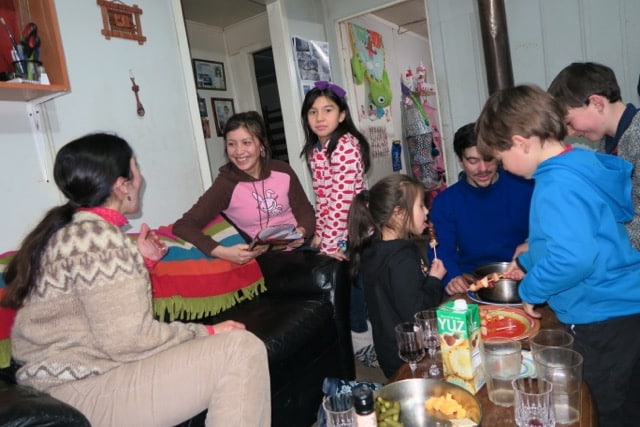
img_0311
The forecasts changed quite a bit from day to day, and we told anyone who asked that we would make the final decision to leave only when we were 24 hours out from suitable weather.
So today was the day. Yesterday we said goodbye to some remarkable people we’ve gotten to know in Puerto Williams, and some remarkable yachtie friends as well. Most of these will join the list of remarkable friends who we’ll never see again, that ghost army of great chance acquaintances who are the result of life in this loose tribe of nomads.
We left Puerto Williams at first light, which is 0400 this time of year.
After we got going we were surprised by two things. The wind was in the southeast, which was unpleasant in that it put us on starboard tack, which is vulnerable just now due to some damaged rigging. I had been hoping for a trip entirely on port tack given the prevailing westerlies. And we caught a ridiculously good current out of Beagle Channel, which swept us far beyond our planned anchorage in Puerto Español, Argentina, which was just as well, as the southeasterlies had made that untenable. We saw the chance to make it all the way through the Straits of Le Maire on the evening tide.
Those straits, between the eastern tip of Tierra del Fuego and Isla de los Estados, have as fierce a reputation as any body of water you’d care to name. I’m glad to be leaving Le Maire behind so easily.
We had thought of anchoring at Isla de los Estados as well. But we have as good a spell of weather ahead of us as we could hope for, so we’ve decided to press on.
With our Old World/New World view of history we think of the Atlantic as old – know to the ancients – and the Pacific as relatively new and recently discovered.
But the Pacific is in fact the older of the two. Which is why it’s so much bigger. It’s just had more time to spread. Consider as well the various taxa – your auks, your sculpins – that are so diverse in the Pacific and so depauperate in the Atlantic.
They simply evolved in the older ocean first, and then secondarily invaded the Atlantic via the Arctic and haven’t had time to do much radiating in their new home.
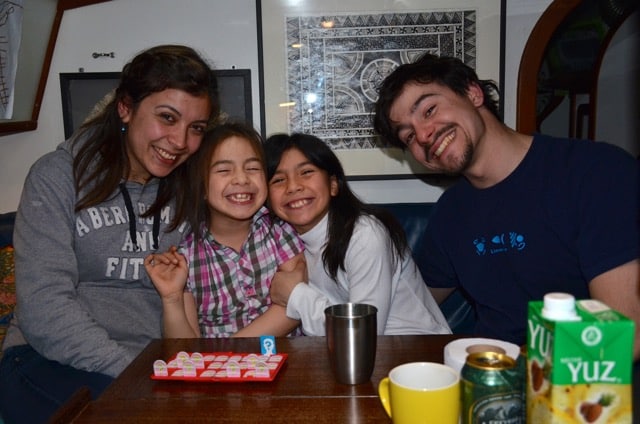
The Atlantic is also new to us.
After eight years of knocking around the Pacific (sometimes literally!), we are, as I write this and the family sleeps, sailing into the Atlantic for the first time.
Across
It was our first passage since we arrived in Valdivia, Chile, nearly a year ago.
I took most of the night watch, with Alisa giving me a break between midnight and three. When I took over again at three it was already light on the horizon. She was glad at my seeming selflessness at taking so much of the night, but I explained that I was happy to do the lion’s share of daytime sleeping and let her ride herd on our over-rested, antsy kids.
All day, two days ago, we watched a small low pressure system moving from west to east across our path, just as predicted by the weather model.
We were well at sea. Out of sight of land and enjoying steady southeasterly winds on the south side of the low. The sun did its best impression of shining – quite a good effort for these latitudes. We were visited by a steady parade of swooping tubenoses: Cape petrels, black-browed albatross, giant petrels, the occasional storm petrels, the truly massive royal and wandering albatross.
After the low passed we found ourselves in the southwesterlies in its wake, driving us strait towards East Falkland. We had stumbled on the completely perfect weather pattern for the passage. We couldn’t have planned it better.
Elias was the first to sight land. He got to choose which packet of cookies we would open for our landfall celebration.
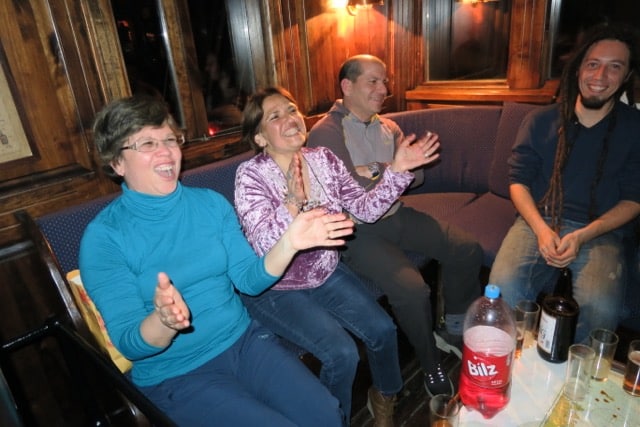
We notified Stanley harbour control of our intention to anchor for the night. A drive through impressive kelp beds brought us to the head of a sandy cove with all the wind you could want. Alisa spotted our first-ever gentoo penguin before the pick was down.
Alisa and I were up again at four to make the 80 miles to Stanley. We had a fast sail, and got to fly the spinnaker in the lull before a front caught us up and had us down to three reefs. We had to remind ourselves of how the weather changes arrive in the South – suddenly and hard.
And just like that, there we were, tying up at the jetty in Stanley next to our mates on Lille d’Elle, who had come out from Ushuaia on the same weather window as us. The customs officer was extremely helpful and cleared us in quickly. We all had a meal and Alisa and I knocked back a celebratory bottle of Chilean wine. Outside, the landscape was so different from the grandeur of continental South America. The town, Alisa noticed, was so neat and litter-free. And now, we have it all to discover.
Time’s Up
I suppose that it’s inevitable that we would find ourselves leaving Puerto Williams, and Chile, with a few things undone.
I had really meant to take a picture of the family in front of the Yelcho, the boat that rescued the crew of the Endurance from Elephant Island – the bow of the Yelcho is set up as a sort of monument in Puerto Williams. Never got around to it.
Likewise, Alisa had meant to make empanadas with Francis and Mauro (in pics above and below) before we left. We almost made that one, but then the right weather for leaving put us in final departure mode and we had to cancel.
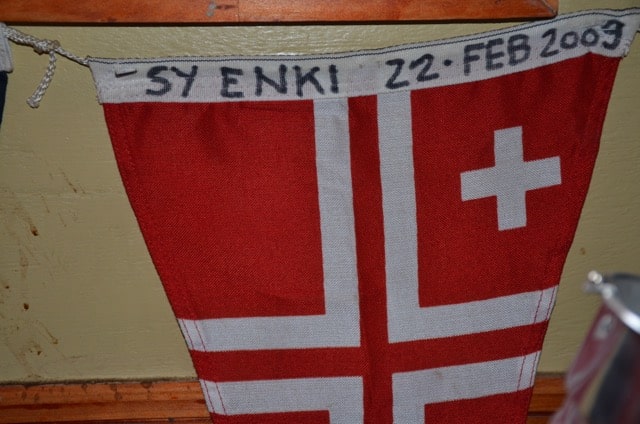
I suppose that it’s inevitable that we would find ourselves leaving Puerto Williams, and Chile, with a few things undone.
I had really meant to take a picture of the family in front of the Yelcho, the boat that rescued the crew of the Endurance from Elephant Island – the bow of the Yelcho is set up as a sort of monument in Puerto Williams. Never got around to it.
Likewise, Alisa had meant to make empanadas with Francis and Mauro (in pics above and below) before we left. We almost made that one, but then the right weather for leaving put us in final departure mode and we had to cancel.
I meant, too, to write at some point about some of the social nights at the Micalvi. The bar is closed, but the ship is still open to sailors for socializing, and we had some great nights there, rubbing elbows with sailors from a great swath of nations who were all united in some vision of the same quest that had brought us all to that point.
Those get-togethers were a phenomenon of the winter. When summer came around people started to come through on a quick schedule, and the social cohesion of the scene disappeared.
I never got around to taking a picture of the Alaskan flag that we left, either. Elias and I put the flag, with our name and home port on it, up on the wall of the Micalvi on our very last day there. It joined a host of strangers’ flags, and a couple flags with familiar names (below).
If you stop by the Micalvi, make sure that it’s still hanging there for us. It’s the only Alaskan flag, and in our haste we could only find three tacks for hanging it on the wall.
When we left Alaska to sail to Australia with our toddler for crew, we thought it was a once-in-a-lifetime thing. But then we had our second child, and bought our second boat, and sailed across the Pacific a second time. We’ve been living aboard for seven years now. Sometimes we wonder how long we’ll keep at it, but all we know for sure is that the end doesn’t seem to be in sight just yet. Click here to read more from the Twice in a Lifetime blog.








